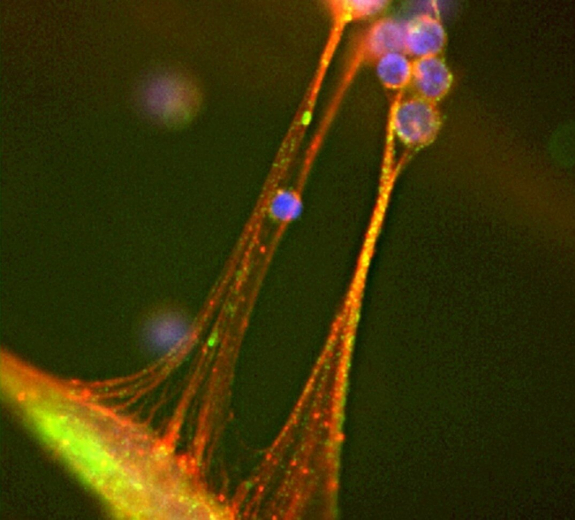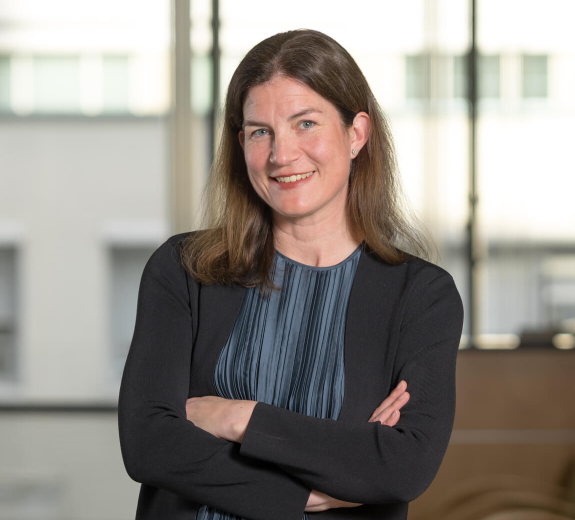Dr. Mikacenic was exploring aspects of acute respiratory distress syndrome (ARDS), a serious inflammation of the lungs that can emerge from a range of different conditions, including pneumonia and now COVID-19. She continues that research now at BRI, as well as research on interstitial lung disease, which is an inflammation that results from many autoimmune diseases, like scleroderma and rheumatoid arthritis (RA). On top of it all, she will be making time to see patients at the Pulmonary Medicine clinic at Virginia Mason.
“I couldn’t be more excited to combine my perspective as a clinician with the brilliant immunologists and other experts I’ll collaborate with at BRI,” she says.
A Common but Mysterious Illness
Although ARDS isn’t very well known to the public, it is a widespread and serious condition. About 150,000 people in the U.S. develop ARDS each year, and 20 to 30 percent of them die as a result. When someone has ARDS, their lungs get so clogged with immune cells and fluid they can’t properly absorb oxygen and pass it into the bloodstream. Basically, the patient is left gasping for air.
“All the news about COVID patients needing ventilators — that’s because they have ARDS,” says Dr. Mikacenic.
In fact, ventilators are the only treatment for ARDS. And all they do is help the patient breathe while doctors wait for the inflammation to go away on its own.
“Currently, there are no drugs or other treatments to address the syndrome itself,” Dr. Mikacenic says. “Discovering those treatments is the main goal of my research.”
The Immune Connection
Back at UW Medicine, Dr. Mikacenic and her colleagues made an interesting discovery: Whereas healthy people have a protein that tells the body to shut down inflammation in the lungs, some people with ARDS have a shortage of that protein.
“This could lead us to treatments that help turn off the immune response behind ARDS,” Dr. Mikacenic explains.
Dr. Mikacenic worked with Alice Long, PhD, and others at BRI on this research, which gave her an early taste of what it’s like to collaborate with the teams here.
“I honestly can’t wait for more,” Dr. Mikacenic says. “The expertise and resources here are tremendous — and we have a lot more to discover about this syndrome.”
Taking Her Research Into New Territory
Like with many conditions, we still don’t know why some people develop ARDS and others don’t. Dr. Mikacenic hopes to discover unique cells or other biological indicators — called biomarkers — that will help doctors predict who’s at risk and how serious their condition is likely to get.
Dr. Mikacenic also plans to study new treatments for people who develop lung problems as part of an autoimmune disease. Currently, these patients are treated with a heavy dose of immunosuppressants, which weaken the entire immune system. While this reduces the inflammation in their lungs, it also leaves the patient vulnerable to infection.
“I would love to find more targeted therapies, so we can attack their lung inflammation and keep their immune system strong at the same time,” Dr. Mikacenic says.
To answer her research questions, she will take full advantage of the experts and resources available at BRI. These include the Genomics Core Laboratory, which has powerful tools for sequencing the kinds of cell populations that Dr. Mikacenic studies, and BRI’s biorepository.
Dr. Mikacenic is particularly thrilled that many donors have provided multiple samples over time. That means, for example, if donors with RA develop lung issues, she can go back to their prior samples and look for cell populations they have in common.
“This is how we’ll identify biomarkers for interstitial lung disease and, eventually, develop treatments to help prevent it,” she says.
Hope for the Future
For now, she is doing the best she can amid the “new normal” of life and work amid the coronavirus. She looks forward to coaching her son’s and daughter’s soccer teams again, when outdoor sports resume.
“I’m Croatian-American, and part of my Croatian heritage is a deep love for soccer,” says Dr. Mikacenic, who played the game both as a youth and as a student at Tufts University.
Although the pandemic has meant limited face-to-face time with her new colleagues, she’s inspired by the energy everyone is devoting to treatments and cures for the virus.
“With so many smart people focused on a single problem, I think we’re bound to make breakthroughs that will help people with ARDS and other lung issues far into the future,” she says.




